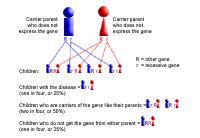Autosomal Recessive: Cystic Fibrosis, Sickle Cell Anemia, Tay-Sachs Disease
We inherit genes from our biological parents in specific ways. One of the ways is called autosomal recessive inheritance.
What is autosomal recessive inheritance?
Autosomal recessive inheritance means that the gene in question is located on one of the autosomes. These are numbered pairs of chromosomes, 1 through 22. Autosomes don't affect an offspring's gender. "Recessive" means that 2 non-working copies of the gene are necessary to have the trait or disorder. One is inherited from the mother, and 1 from the father. If you have only 1 recessive gene, you are a "carrier" for the trait or disease, but you do not have any health problems from "carrying" 1 copy of the gene. Most people don't know they carry a recessive gene for a disease until they have a child with the disease, or they have another family member with the disease. It's estimated that all people carry about 5 or more recessive genes that cause genetic diseases or condition. Once parents have had a child with a recessive trait or disease, there is a 1 out of 4, or a 25%, chance that with each subsequent pregnancy, another child will be born with the same trait or disorder. This means that there is a 3 out of 4, or a 75%, chance that another child will not have the trait or disease.
What are autosomal recessive disorders?
Mutations (or changes in the DNA) have occurred over time in different parts of the world. Anyone can carry any type of recessive gene. However, certain ethnic groups are more likely to carry certain recessive genes, because of where the mutation originated. For example, the gene that causes Tay-Sachs disease is found most commonly in people of Ashkenazi Jewish descent. This population is from eastern Europe, where experts believe the mutation originated. The disease also affects those who are not of Ashkenazi Jewish descent.
What are some of the different types of autosomal recessive disorders?
Examples of autosomal recessive disorders include cystic fibrosis, sickle cell anemia, and Tay-Sachs disease.
Cystic fibrosis
Cystic fibrosis (CF) is a common, inherited, single-gene disorder, in Caucasians. People with CF produce mucus that is abnormally thick and sticky that can damage body organs. The mucus interrupts the function of vital organs, especially the lungs, and leads to chronic infections. CF also involves the pancreas and causes decreased absorption of essential nutrients and can cause reproductive system damage. With improved treatment and management of the disease, affected people may live well into adulthood. Ultimately, death most often occurs from respiratory failure. Other people with variants of CF may have only lung involvement, sinusitis, or infertility.
Sickle cell anemia
Sickle cell anemia is another common, inherited, single-gene disorder found mostly in African-Americans. About 1 in 500 African-American babies is born with sickle cell anemia. About 1 in 12 African-American people carries the gene for this disease. Sickle cell disease involves the hemoglobin in the red blood cells, and their ability to carry oxygen. Normal red blood cells cells are smooth, round, and flexible, like the letter "O." They can easily move through the vessels in our bodies. Sickle cells are stiff and sticky. When they lose their oxygen, they form into the shape of a sickle, or the letter "C." These sickle cells tend to cluster together and can't easily move through the blood vessels. The cluster causes a blockage and stops the movement of healthy, normal, oxygen-carrying blood. This blockage is what causes the painful and damaging complications of sickle cell disease.
Sickle cells live only for about 15 days. Normal hemoglobin cells can live up to 120 days. Sickle cells risk being destroyed by the spleen because of their shape and stiffness. The spleen helps filter the blood of infections. Sickle cells get "stuck" in this filter and die. Due to the decreased number of hemoglobin cells circulating in the body, a person with sickle cell is chronically anemic. The spleen also suffers damage from the sickle cells, which block the healthy oxygen-carrying cells. After repeated blockages, the spleen is very small and does not work properly. Without a functioning spleen, these people are more at risk for infections. Infants and young children are at risk for life-threatening infections. Treatment includes prompt emergency care for fevers and infections, appropriate vaccinations, penicillin, and management of anemia.
Tay-Sachs disease
Tay-Sachs disease is a fatal disorder in children (usually by age 5) that causes a progressive degeneration of the central nervous system. It is caused by the absence of an enzyme called hexosaminidase A (or hex A). Without hex A, a fatty substance builds up on the nerve cells in the body, particularly the brain. The process begins early in pregnancy when the baby is developing. It is not apparent until several months after the birth. To date, there is no cure for Tay-Sachs. About 1 in 27 persons of European Ashkenazi Jewish ancestry carries the Tay-Sachs gene.

Connect with us:
Download our App: